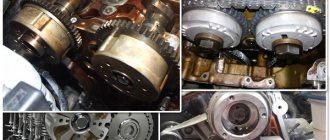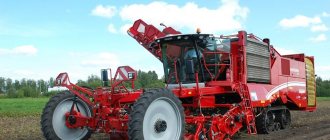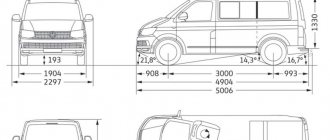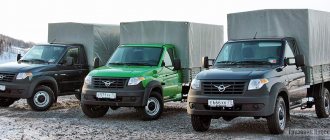dimensions
The Volkswagen Transporter was developed as a maneuverable compact utility vehicle. It is easy to drive in the city and can be driven off-road or on bad roads.
The dimensions of the Volkswagen Transporter have not changed dramatically over the course of six generations.
The average dimensions given are measured at the extreme points of various sections of the car.
- length – along the longitudinal section, it is important that the points are in the same plane
- width - transversely, focusing on the wheel arches or B-pillars of the body
- height of the Volkswagen Transporter - the lower measuring point is on the surface, the upper one is on the roof (without roof rails).
The usual dimensions of the conveyor are 4304x1904x1960 mm.
Even in the 6th generation, the canonical dimensions of the Volkswagen Transporter were preserved (with the exception of the ceiling height).
There are also extended cars - this modification is offered as an option. There is a slight variation in size, depending on the model.
Reference! This car is known as Bully, bull, bus, camper, combi. The official name is commercial van.
Modifications
The car is available in two lengths and three roof heights. The car also has a huge number of other body variations:
- closed van;
- minibus with the ability to transport nine people;
- cargo platform with 2-door cabin;
- cargo platform with 4-door cab;
- cargo platform with sides;
- conversion into an ambulance, refrigerator, cash-in-transit vehicle and other special services;
- model with sliding doors replaced with regular ones;
- model prepared for camping.
Engine and gearbox parameters
The conveyor is available with a whole range of engines. Different volumes and powers, as well as the ability to choose fuel.
Volkswagen engines have proven themselves to be the best from the very beginning. Even in the first models, which had air-cooled engines, reliability and ease of operation were noted.
Fuel consumption
In addition to maintainability and reliability, car enthusiasts note efficiency - an important factor when choosing a car that is planned to be used daily and loaded.
The threshold value according to tradition is 10 liters per hundred km. The average appetite of conveyor engines is from 5.8 to 10.7 liters.
If we talk about the models that are in use today, then we should start with the T4. In the city, a car with a two-liter engine consumes about 11 liters, on the highway - 8.
Larger engines, which are installed optionally, consume more - in the city up to 12 liters, on the highway - up to 8.
Fuel consumption of a Volkswagen Transporter largely depends on the fuel, gearbox and driver skill. There is also some connection with speed - the optimal speed for economy is 100 km/h.
Diesel engines are more economical, and the most powerful engines consume much less, especially on the highway. For example, a 2.5 liter engine and 102 hp. with all-wheel drive, the consumption on the highway is no more than 6.5 liters.
Dynamics
If we consider the evolution of transporter motors, we can see what a serious development path this car has gone through.
Read also Review of Multiven T5
The first models were equipped with not very powerful engines and moved at a low speed of up to 125 km. But it was this line of engines that gave the conveyor the reputation of an incredibly reliable machine. You could drive up to 180,000 km and never contact service.
The car systems had flaws and breakdowns, but spare parts were cheap. Plus, you could quickly learn how to independently solve many problems. This is the basis of the enduring love for this car - they are bought even with huge mileage, after many owners. And they remain quite satisfied with their purchase.
At the turn of the century, the line of engines began to be modified. A range of ACV engines appeared, up to 105 hp, high torque and other improved characteristics. Various upgrades to the propulsion system have reduced their durability somewhat. Now problems could begin after the first hundred miles. But the engines remained unpretentious and repairable - in the Volkswagen style.
Reference! For those who want to buy an engine of this class, the recommendation is that the best engines are considered to be: gasoline - 1.6/103 hp, diesel - 1.8 l/110 hp. The units were installed on the conveyor starting from the fourth generation. These are the strongest and most reliable motor models.
The concern's modern motors are high-tech devices that form a completely different group of engines. We can say that with the updated line of engines, the legendary reliability of the first transporters has been revived.
Interesting models are ACV, which are installed on all conveyors, including T4. Maintainability has increased - the concern drew attention to the fact that many spare parts of the conveyor can be replaced with parts from other manufacturers and modified its spare parts to general parameters. Now owners have a large selection of spare parts for cars of any generation.
It is impossible to list all modifications of Volkswagen engines, but you can pay attention to several models that are currently in use.
- 2.6 TDI Transporter - produced since 2007. To this day in top positions. The reason for its popularity is not the power, which for this model is quite average, 110 hp, but the resource, which allows you to drive up to 200,000 km without repair problems. This makes it practically the only truck engine with this level of reliability.
- Another popular and recommended engine is the 2.5 TDI. Inexpensive, repairable, with a large number of components and spare parts in any store. This model may need cylinder repairs, this is its weak point. Still a popular model.
- Among diesel engines, the famous model is ACV 2.0. After its introduction to the market there was a boom period - which is surprising for engines. This is a successful development of the concern, which is still in the lead. The unit is strong, reliable, and eats little. In the city he needs about 8 liters, on the highway - no more than 8.5. And the simplicity of its design has become legendary - its repairs are carried out by the owners themselves, after becoming familiar with its design.
Read also Review of the new Volkswagen Tharu 2020 SUV
Engines are an important component of the concern’s success:
- the first generations became famous for their resourcefulness and reliability
- then the main quality became wear resistance
- The latest generations of engines are recognized as the best options for utility vehicles.
So far, no one has been able to overtake Volkswagen in the development of engines for transporters.
Reference! The transporter, as an idea for cargo and passenger transportation, has been implemented for 70 years, since 1950. And always with success.
Volkswagen Transporter T5 interior
The West car and interior are imbued with German practicality. The first copies had a slightly sparse design, but after restyling the model received a completely new and modern interior, which is relevant even today. Among the disadvantages it has is thin and cheap plastic, which should rumble on any uneven surfaces, however, competent German engineers equipped everything with a large amount of sealing, which gives maximum comfort for commercial vehicles.
Modifications with cargo platforms have a more sparse interior than passenger versions.
The driver's seat is well equipped, and overall ergonomics are at the highest level. From the driver's seat it is not difficult to reach any controls. The steering wheel is 3-spoke with a modern design and a large number of buttons. In the center it is decorated with a small company emblem, and behind the steering wheel there is a colored instrument panel with red arrows and a large on-board computer display. All this is protected from solar blocks by a huge rounded visor.
The center console, descending, goes into a semi-horizontal position. At the highest point there is a small niche for documents, followed by a large display of the Volkswagen Transporter T5 multimedia system, on the sides of which there are air ducts with a vertical orientation. The climate system control unit fits very organically in the center, and on the sides there is a scattering of identical keys for controlling the functions of the car. The gearshift knob is also located on the dashboard, which makes the front floor absolutely flat, despite the modification of the car.
As standard, the seats have fabric upholstery, but leather is also available for the passenger version. The seats themselves have a fairly rigid filling, pronounced lateral support and a suitable range of adjustments.
As for the cargo compartment of the Transporter T5, the floor there is made of corrugated metal, and the volume in the cargo compartment with a standard wheelbase and a low roof is 5,800 liters. The extended version with a high roof boasts a volume of 9,300 liters.
Capacity and load capacity
The very first conveyor had a load capacity of 860 kg. After some time it was increased to 930 kg. The maximum capacity of the vehicle is 13 people; the first generation campers could accommodate 4 people (or 5, but with some inconveniences).
The second conveyor was practically no different in this parameter, as was the third. All three models did not move if the load exceeded the specified threshold.
The T4 is a significant step forward in many ways. The efficiency of transportation has also increased - the carrying capacity has increased to just over a ton.
The T5 became even more durable - it could carry 200-300 kg more than its predecessor, its maximum was 1400 kg (Kasten cargo package).
T6 also remained within the framework defined by the manufacturer half a century ago. But this model can hardly be called a vehicle for cargo transportation.
Brief history of creation
The production of the first German Volkswagen Transporter cars began in the 40s of the twentieth century. In 1965, the T1 model appeared, and by the end of the 70s, the automobile concern had mastered the production of third-generation cars. Transporter T3 rolled off the assembly line for more than 10 years, but, having become morally obsolete, was improved into a new model - T4, significantly different from its predecessors.
From 2006 to 2009, the Transporter T5 was produced, with the greatest variety of designs: station wagon, van, truck.
Other auto parameters
- Suspension is the strong point of transporters. From the first generations, she gained a reputation for being unkillable. From the 1st to the 6th generation it was refined, especially on the T4, which became front-wheel drive. Modern suspensions on the T6 are completely independent, struts and multi-link designs.
- The steering wheel is rack and pinion; already in the second generation, power steering is optionally offered, which will then be included in the basic configuration.
- Starting from the first generation, everything is installed in the car for the comfort of the driver and passengers. The latest generation has everything that makes a car a comfortable second home.
Malfunctions of Volkswagen Transporter T5
- A 4-cylinder diesel engine cannot cope with loads and often has problems with pump injectors;
- The 2.5 liter diesel engine is subject to early wear of liners and compensators;
- Every 100,000 km, the generator overrunning clutch “dies”;
- The biturbo version of the engine often has increased oil consumption;
- The flywheel often does not reach 20,000 km on the same biturbo engine;
- With regard to the transmission, problems arose only with the DSG robot, the owners of which, after 150,000 km, contacted the services, but there everything was done with a harmless flashing;
- The suspension will have to be “overhauled” every 150,000 km.
As for the body, owners complain about failure of power windows, leaking seals and rapid wear of the rollers on the side doors. The problem with corrosion resistance in the fifth generation has also not been resolved.
On the Russian market, pre-restyling models are sold in the price range of 500,000-700,000 rubles, and restyling will cost 900,000-1,400,000 rubles.
Despite its shortcomings, the Volkswagen Transporter T5 remains the same “workhorse”. This car with a powerful history was, is, and will continue to be appreciated.
Marchello – Re tank volume t4
| Technical characteristics and dimensions of the Volkswagen Transporter If you drive through ordinary potholes, then even an honest and diligent person may have fuel consumption; most of the time I spend increased load on the driver’s spine. For the first type of power unit, this figure is 9.2, 6.9 and 7.8 liters, respectively, for the second 9.6, 7.1, and 7.9 liters, respectively, and for the third 9.8, 7.1 and 8.0 liters respectively. |
| Volkswagen Caravelle - technical characteristics: overall dimensions, fuel consumption, tank volume, ground clearance 6 7 10 12, VW G 052 162 semi-synthetic oil for automatic transmission Power steering 1.0 DEXRON II-D or DEXRON III, VAG G 004 000 M2 Power Steering Fluid G004 Brake fluid 0.5 DOT 3 or DOT 4. The Caravel compares favorably with its competitors in that it is not quite a minibus, but also not a crossover; the handling is the same as that of a passenger car, despite the fact that the capacity is much higher than most SUVs, the third row is installed without loss of comfort. |
- Trims: 2.0 TSI Kombi Long High roof, 2.0 TSI Kombi Long Medium roof, 2.0 TSI Kombi Long Standard roof, 2.0 TSI Kombi Medium roof, 2.0 TSI Kombi Standard roof, 2.0 TSI DSG Kombi Long High roof, 2.0 TSI DSG Kombi Long Medium roof , 2.0 TSI DSG Kombi Long Standard roof, 2.0 TSI DSG Kombi Medium roof, 2.0 TSI DSG Kombi Standard roof
- Engine: CJKA
Re: T4 tank volume? • Last edited by Horseman on June 18, 2022, 00 51, edited 1 time in total.











